The ‘hermit state’ had almost no Covid in 2021 due to its extreme zero Covid policies, so WA vaccine safety data provides unique insight into vaccine effects absent the confounder of Covid infection
The West Australian government has finally released its 2021 vaccine safety surveillance report,1 6 months behind its promised publication date of August 2022. The equivalent national report was released in September of last year.
WA Gov has offered no reason for why they sat on this report for so long before publishing it, but the attitude of Minister for Health, Amber-Jade Sanderson gives a clue. When petitioned last year by thousands of West Australians to publicly release the health advice on which WA Gov based their extreme pandemic policies, Sanderson not only refused to make the health advice freely available, but countered that in asking for transparency from the government, petitioners were somehow seeking to, “undermine the Government’s efforts to keep Western Australians safe.” So much for the Labor government’s much touted promise of ‘gold standard transparency.’
Unique to WA vaccine safety surveillance data from 2021 is the fact that vaccine effects can be easily differentiated from Covid infection effects. There was almost no Covid in WA in 2021, due to WA’s extreme zero covid policies.2 In contrast, almost four million doses of Covid vaccination were administered to the population during 2021.
The Covid jab rollout began on 22 February 2021 in Western Australia. You can see when it began.
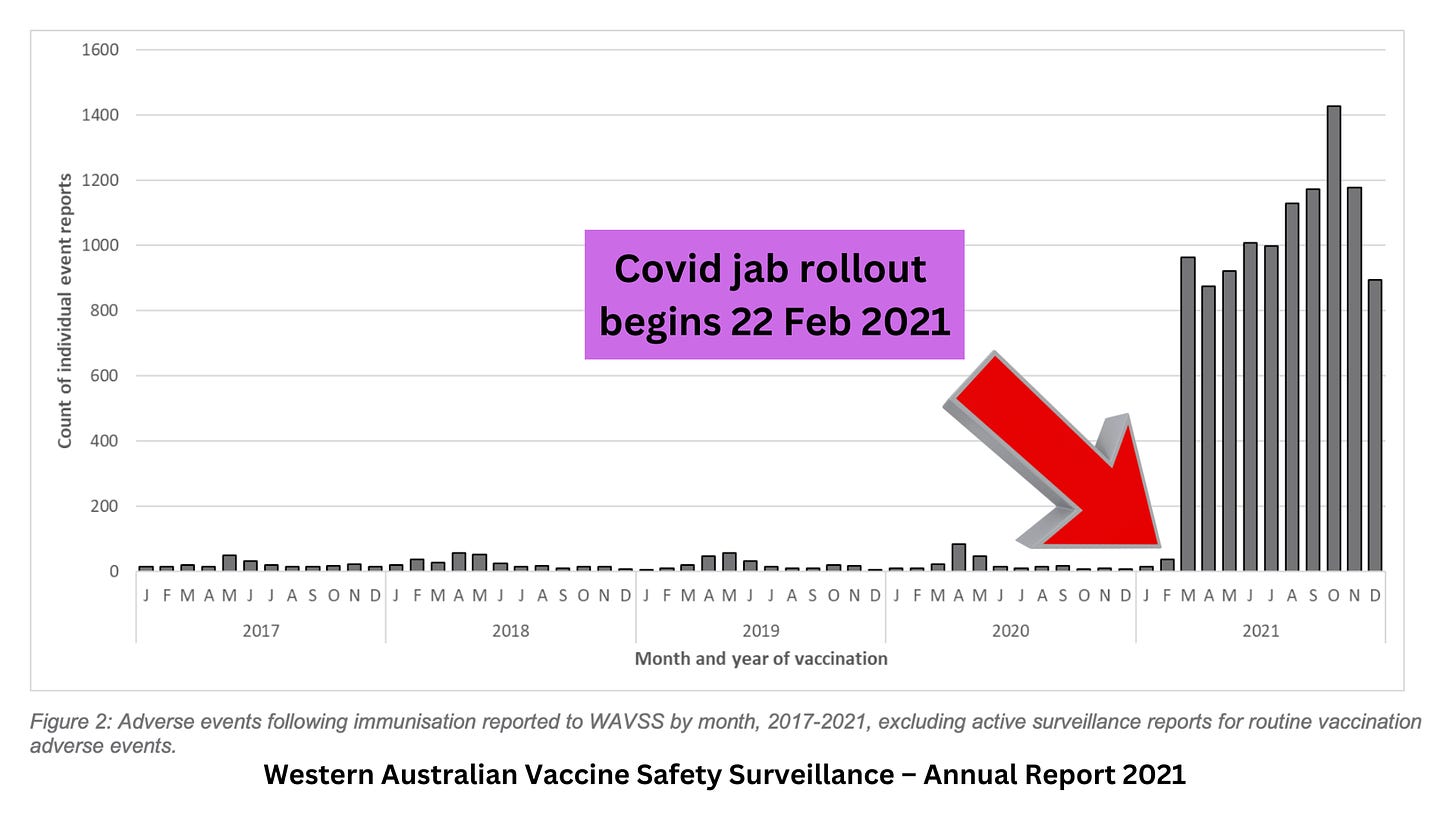
In 2021, adverse events following immunisation (AEFIs) with the Covid vaccines were reported at almost 24x the rate (per 100, 000 doses) of AEFIs for all other vaccines combined. The report refers to this phenomenon as an “exponential increase.”

From the report (emphasis mine):
“The number of adverse events following immunisation (AEFI) reported to Western Australia Vaccine Safety Surveillance (WAVSS) was significantly higher in 2021 than in previous years (10,726 compared with an average of 276 per year for the 2017-2020 period) due to the introduction of the COVID-19 vaccination program.”
The total number of reported AEFIs for all vaccines combined (including Covid vaccines) in 2021 was 38x the average for the preceding four years. By comparison, the increase in the total number of vaccine doses administered (before Covid vaccines) in 2021 (5,756,723 doses) was only 2.8x the number administered in 2020 (2,071,167 doses).
The biggest month for AEFI reports, October 2021, is the same month in which the eligibility criteria was expanded to all people aged >18, walk-in vaccination became available, and vaccine mandates for the majority of WA workers were announced.

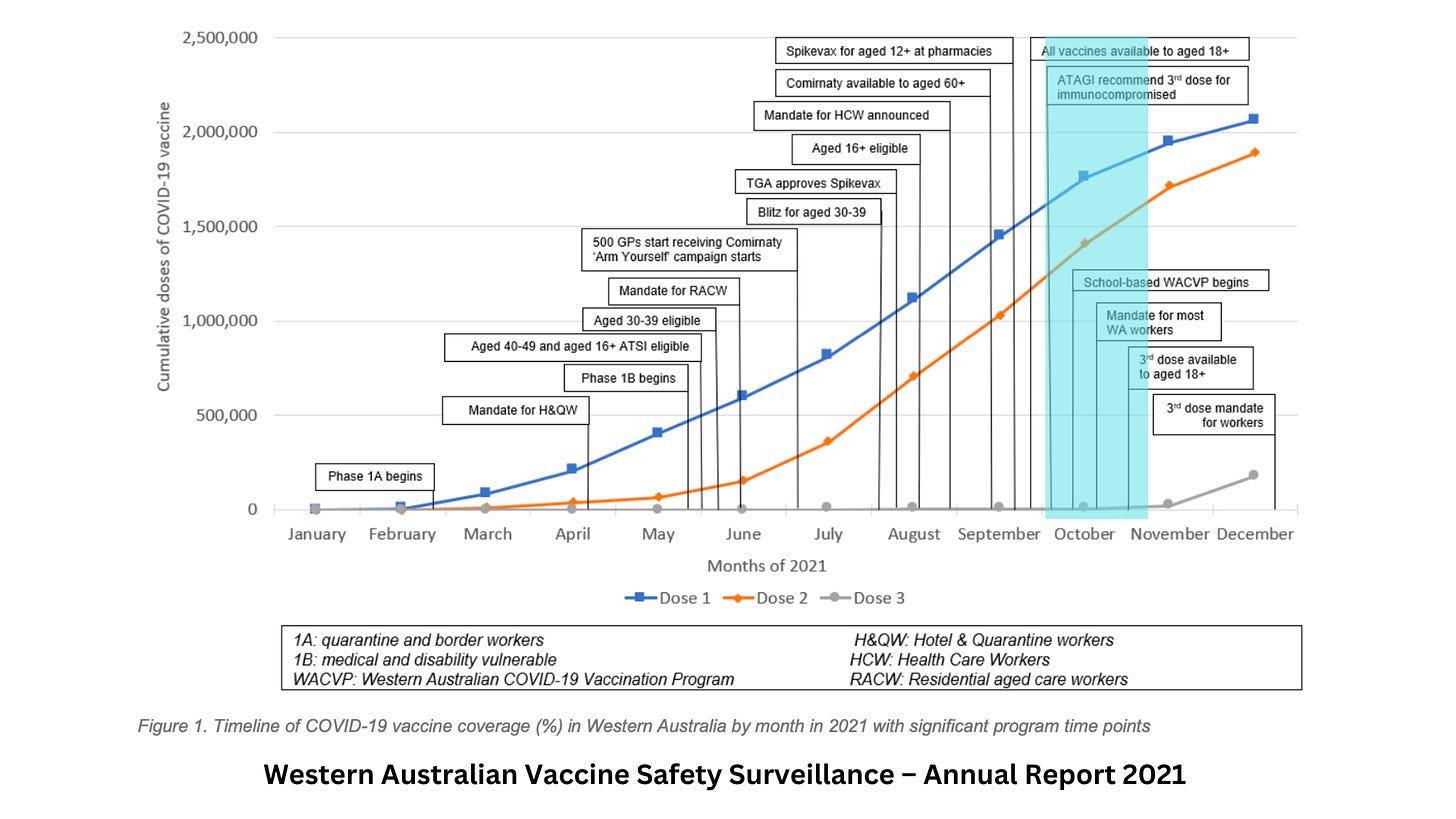
KEY POINTS
The AEFIs disproportionately affected women, with the majority (64%) of reported AEFI cases being female.
57% of AEFIs were treated in the emergency department (ED) or in the hospital.3 This is in contrast to the TGA’s communications with me earlier this year, when a spokesperson stated, “Reassuringly, the majority of adverse event reports for COVID-19 vaccines have been for common, expected and frequently mild reactions.” There’s nothing mild about being rushed to ED, so either WA is an outlier, or the TGA’s statement is misleading, on a level with ‘being rushed to ED after vaccination is common and expected, so don’t be alarmed if you end up in ED.’
Most AEFIs (58%) were self-reported, with only 35% being reported by healthcare providers. In WA, it is a statutory requirement for health professionals to report AEFIs. However, it is likely that as of at least March 2021, medical professionals were reluctant to report AEFIs due to fear of reprisal from the regulator, AHPRA, whose March 2021 position statement expressly forbade medical professionals from taking any actions that could be perceived as undermining the Covid vaccination rollout.4 The fact that the majority (79%) of routine vaccine AEFIs were reported by healthcare providers supports this argument. It is also likely that many health professionals were simply not aware that some AEFIs were related to Covid vaccination in 2021, and hence were less likely to report them than AEFIs for more established vaccines. In the first year of the rollout, many women reported anecdotally of being told by their doctor that Covid vaccines can’t affect menstrual cycles, but research finally confirmed in 2022 that in fact, this is one of the most common side effects of Covid vaccination for women.

Those aged 30-49 were hit hardest, with AEFI rates of 314-316 per 100, 000 doses. The 50-59 age bracket fared the third worst. This is significant when you consider that these groups make up the majority of the workforce, and that over half of all AEFIs were treated in ED/hospital. AEFIs for children under 12 years old do not feature in this report, as the Covid vaccines weren’t approved for kids aged 5-11 until December 2021.
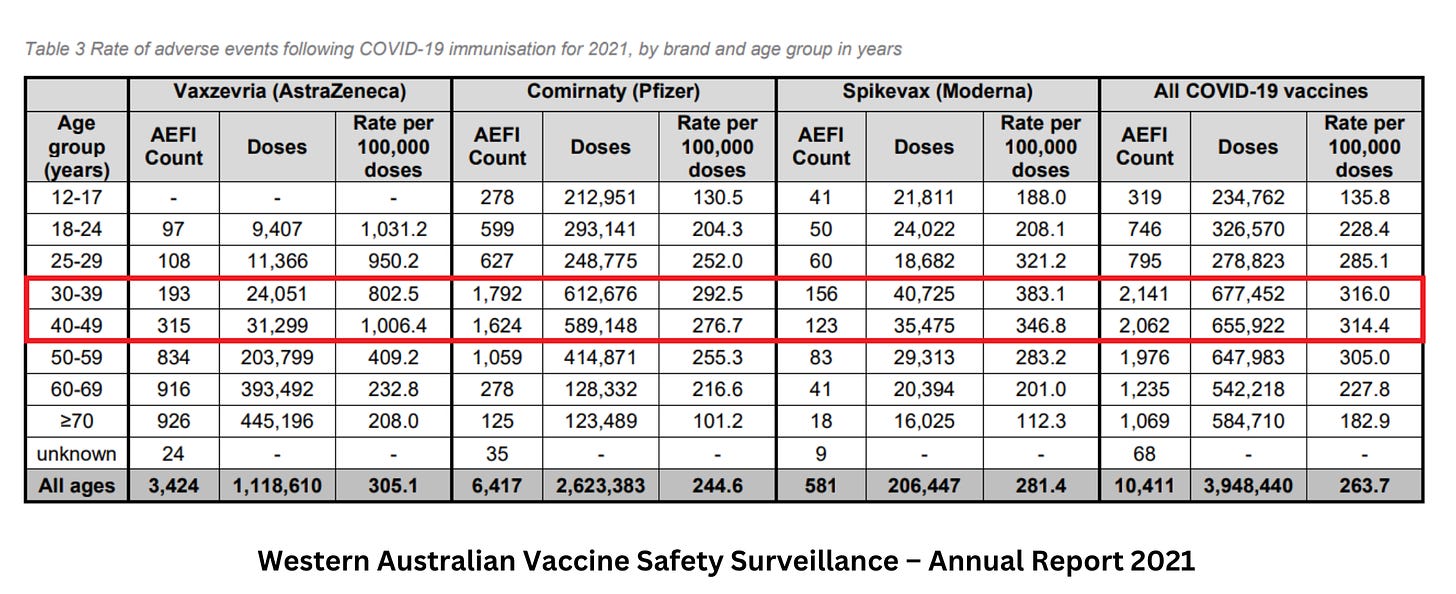
Background rates of myocarditis and pericarditis increased by 35% and 25%, respectively, in 2021 compared to the prior five-year average. As already established above, this increase cannot be attributed to Covid infection, as WA had almost no Covid cases in 2021. What we did have was almost four million doses of Covid vaccination. More on myo and pericarditis in the next section on serious AEs.

Chest pain was the fifth most commonly reported AEFI for Covid vaccines in 2021.

ESPECIALLY SERIOUS ADVERSE EVENTS
CONTEXT: Vaccines have been withdrawn from the market for the following rates of serious AEFIs:
- The swine flu vaccine (1976) was withdrawn for a rate of one serious case of Guillain-Barré syndrome per 100, 000 doses.
- The rotavirus vaccine, Rotashield (1999), was withdrawn for a rate of one-to-two serious cases of intussusception per 10, 000 doses.
- The TGA withdrew Fluvax Junior (2010) for children aged 6 months to <5 after 25 reports of febrile convulsions following vaccination (16 of which were from WA) triggered an in-depth investigation, which determined a causal link between Fluvax Junior and increased risk of febrile convulsions.5
Note that the below includes confirmed cases only. These are cases that have been assessed and determined, by the WA Vaccine Safety Advisory Committee (WAVSAC) or other relevant health professionals, to be causally linked to vaccination.
Anaphylaxis is a life-threatening allergic reaction. Out of 181 cases reported, 49 were diagnostically confirmed, 47 cases were determined uncertain, and 73 cases were awaiting review at the time the data was analysed. The first dose of Pfizer’s Comirnaty and AstraZeneca’s Vaxzevria carried the highest risk, at 2.4/100,000 and 1.9/100,000 doses, respectively.

Thrombosis with thrombocytopenia syndrome (TTS) is a known serious side effect of Vaxzevria, identified in 2021. 13 cases of TTS were confirmed or probable. For those aged >60, the rate of TTS after Vaxzevria was 2.1/100,000 doses, which is on par with national figures reported by the TGA at the time that this data was analysed.

Immune thrombocytopenic purpura (ITP) is an autoimmune disease in which the immune system attacks platelets in the blood and megakaryocytes in the bone marrow resulting in low platelet counts, causing easy bruising and bleeding. 30 cases of ITP were confirmed, and once again, the first doses of Vaxzevria and Comirnaty were the most dangerous, at a risk rate of 3.5/100,000 and 1.9/100,000 doses, respectively.

Guillain-Barré syndrome (GBS) is a serious immune disorder when nerves are attacked by immune cells resulting in pain, numbness, muscle weakness and/or difficulty walking. 14 cases of GBS were confirmed following Covid vaccination. The first dose of Vaxzevria carried a risk of 1.2/100,000 doses.
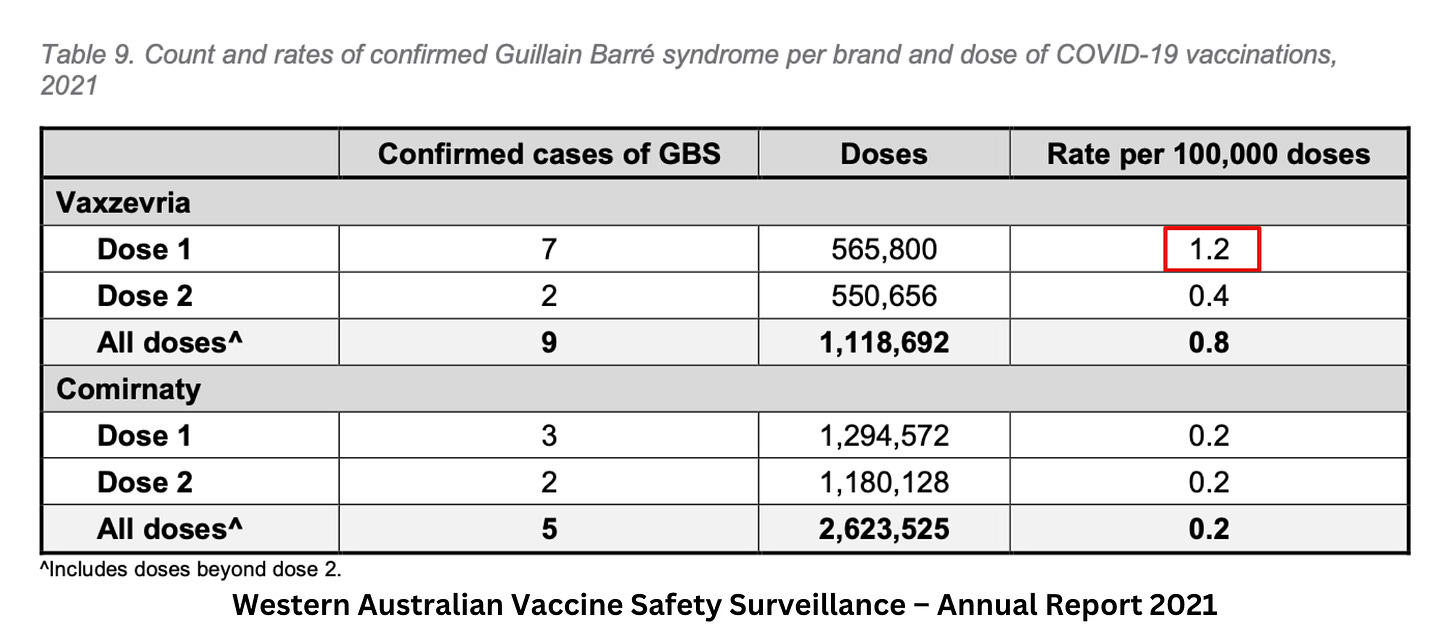
Myocarditis is inflammation of the heart muscle and pericarditis is inflammation of the pericardium (the thin, sac-like tissue surrounding the heart muscle). Myocarditis and pericarditis can occur together or separately – when they occur together it is called myopericarditis.
The below table shows the 138 confirmed cases of myocarditis or myopericarditis reported to WAVSS in 2021. Moderna’s Spikevax is by far and away the standout product in this category (not in a good way), with a risk of 7.3/100,000 doses, increasing to 12.9/100,000 on dose two. Comirnaty carries an overall risk of 4.5/100,000 doses.
Interestingly, these rates are more than twice the national average at the time this report was compiled, with the TGA reporting rates of myocarditis/myopericarditis at 2.2/100,000 doses of Spikevax and 1.5/100,000 doses of Comirnaty.
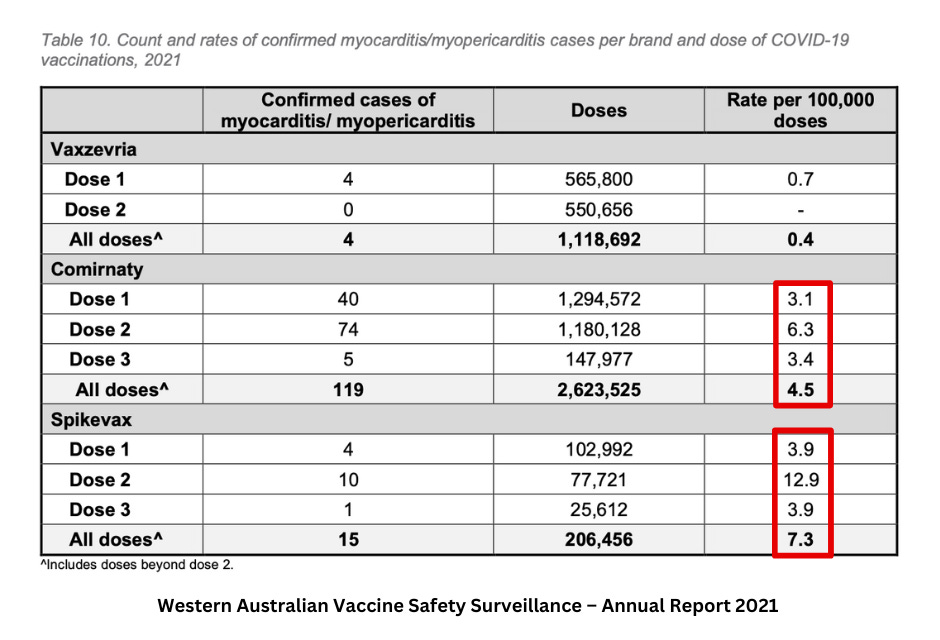
When you break it down by age, the risk skyrockets in certain brackets. Again, Spikevax is the standout, with a myocarditis/myopericarditis risk of 21.4/100,000 doses for those aged 25-29 years.
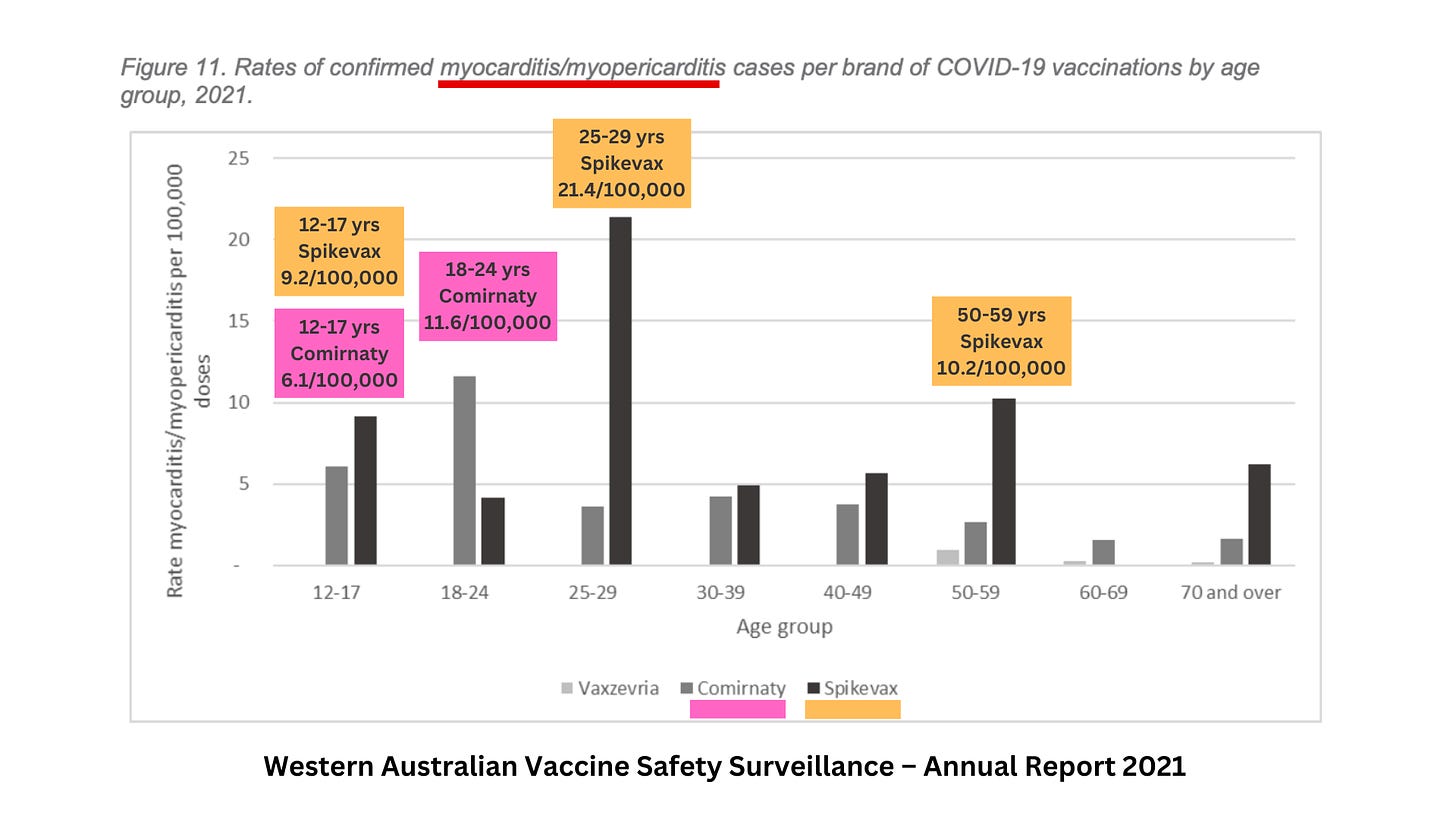
Of the total 365 confirmed cases of pericarditis, risk was again higher on the first dose, 24.3/100,000 doses for Spikevax, and 14.4/100,000 doses for Comirnaty. The combined risk/dose rate is 18.4/100,000 doses of Spikevax, and 11.9/100,000 doses of Comirnaty.
National pericarditis rates reported by the TGA were 8.6/100,000 doses of Spikevax and 7.1/100,000 doses of Comirnaty, so once again, WA’s confirmed cases represent a significantly higher risk rate.

Rates of pericarditis for 2021 by age are shown in Fig. 12, below. WOAH, BIG BLACK ARROW – the rate of pericarditis cases occurring after Spikevax is 53.5/100,000 doses in the age bracket of 25-29 years.
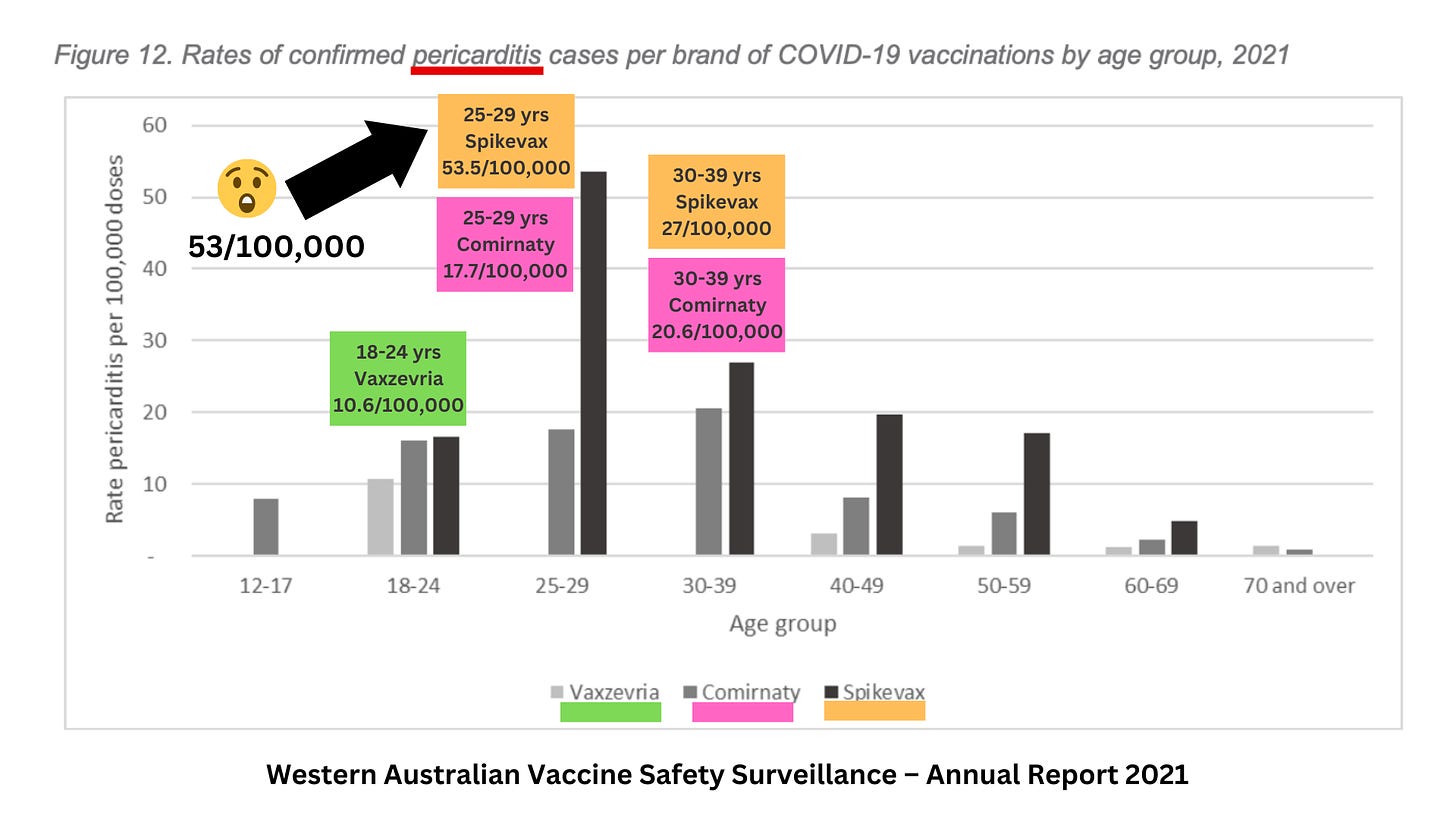
87 deaths were reported, with at least 40 of these being identified in active surveillance and having occurred within 21 days of vaccination. Only one death was confirmed to be causally linked to vaccination. There needs to be further transparency about how WAVSAC conducts such assessments, however this information falls outside of the scope of this report.6
Ramsay Hunt Syndrome is listed as an AEFI of special interest (Appendix 3), the same condition that has afflicted Justin Bieber since mid-2022. Bieber is yet to make a full recovery, announcing last week that he has had to cancel more tour dates scheduled for this year. Bieber has never announced his vaccination status publicly, but in 2021, his promoters announced a vaccine mandate for attendance of his South Africa tour to apply to everyone >12 years old.

MORE AEFIs, BUT NOTHING TO SEE HERE
About the massive increase in AEFI reports after Covid vaccination, the report states,
“The high number of reports in 2021 following COVID-19 vaccination reflects higher uptake of COVID-19 vaccination, and high engagement from the public and health care providers with the monitoring of vaccine safety.”
“The COVID-19 vaccination program attracted considerable public interest and media attention in 2021, almost certainly increasing public awareness of vaccine safety. This increase in publicity may have contributed to increased awareness of AEFI and increased reporting of COVID-19 vaccine AEFI to WAVSS.”
The report does not raise or address the possibility that an increased reporting rate (not raw numbers, but rate) could partly be due to the fact that the Covid vaccines cause more AEFIs than traditional vaccines.
The report cites academic literature7 to support its explanation of more publicity = more AEFI reporting, and I concede that point. However, there is no mention of why this particular class of vaccines might have attracted public interest and media attention regarding safety concerns. You know, like the spate of vaccine injuries that occurred during the trials but were covered up, or the injuries that started occurring immediately after the rollout, or the experimental nature of the mRNAs, or the unprecedented mass coercion of the entire West Australian population to undergo a novel medical procedure in exchange for the right to work or see their families.
WHAT THEY GOT RIGHT
The introduction of data linkage between WA’s active surveillance system, SmartVax and the WAVSS passive surveillance system has improved the detection and reporting of AEFIs.
From the report,
”In 2021, 230 possible AEFI following COVID-19 vaccinations that had not already been reported to WAVSS were identified using the newly established data linkage active surveillance system.”
The data linkage system also identified 40 of the total 87 reported deaths.
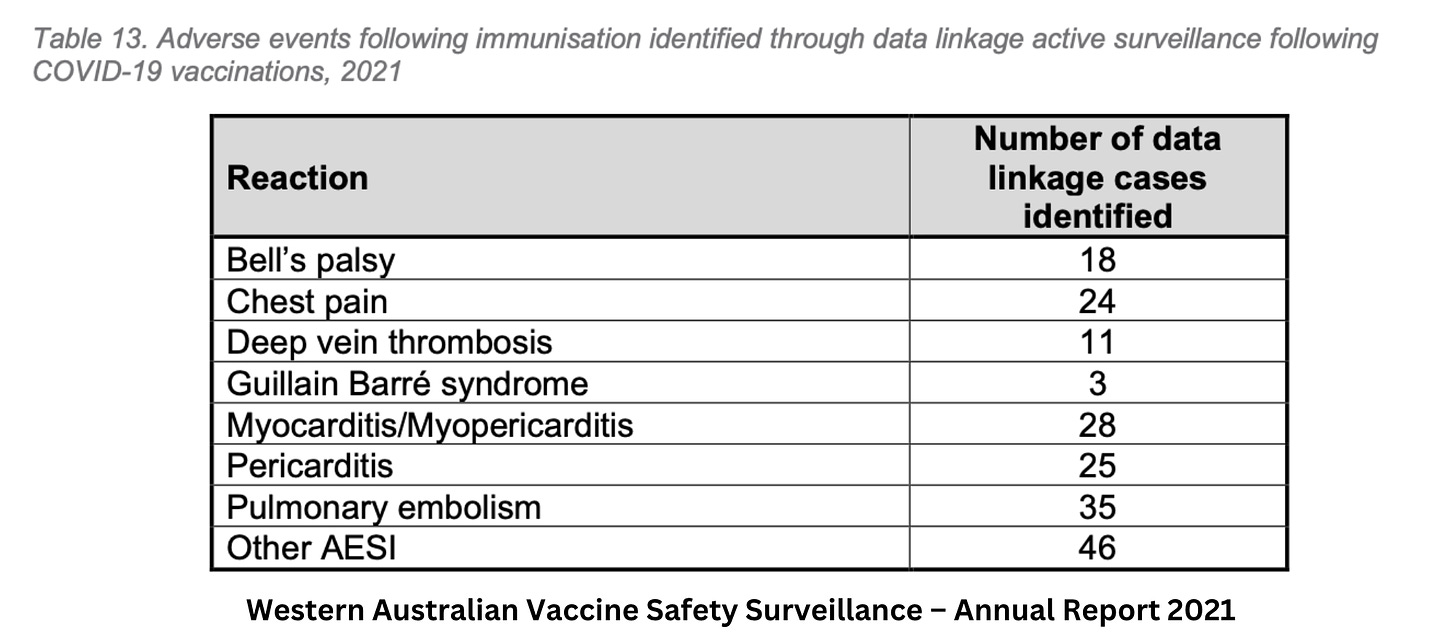
I find the wording in the report unclear, but from cross-referencing against reports from prior years, it appears that the SafeVax (active) and WAVSS (passive) systems used to analyse their data independently, with each body reporting on AEFIs from its own data set only. What is different from 2021 is that the WAVSS report includes SafeVax surveillance data. This is much better than the previous system, so credit where credit is due.
For some reason, WAVSS included SafeVax data on Covid vaccine AEFIs, but not on other vaccines in this report. If they had included the 98 AEFIs reported under SafeVax surveillance of all other vaccines, then the proportion of Covid vaccine AEFIs would be 16x all other vaccines (as opposed to 24x). I don’t know why WAVSS chose not to report the SafeVax data for vaccines other than the Covid ones. WA Health has been contacted for clarification.
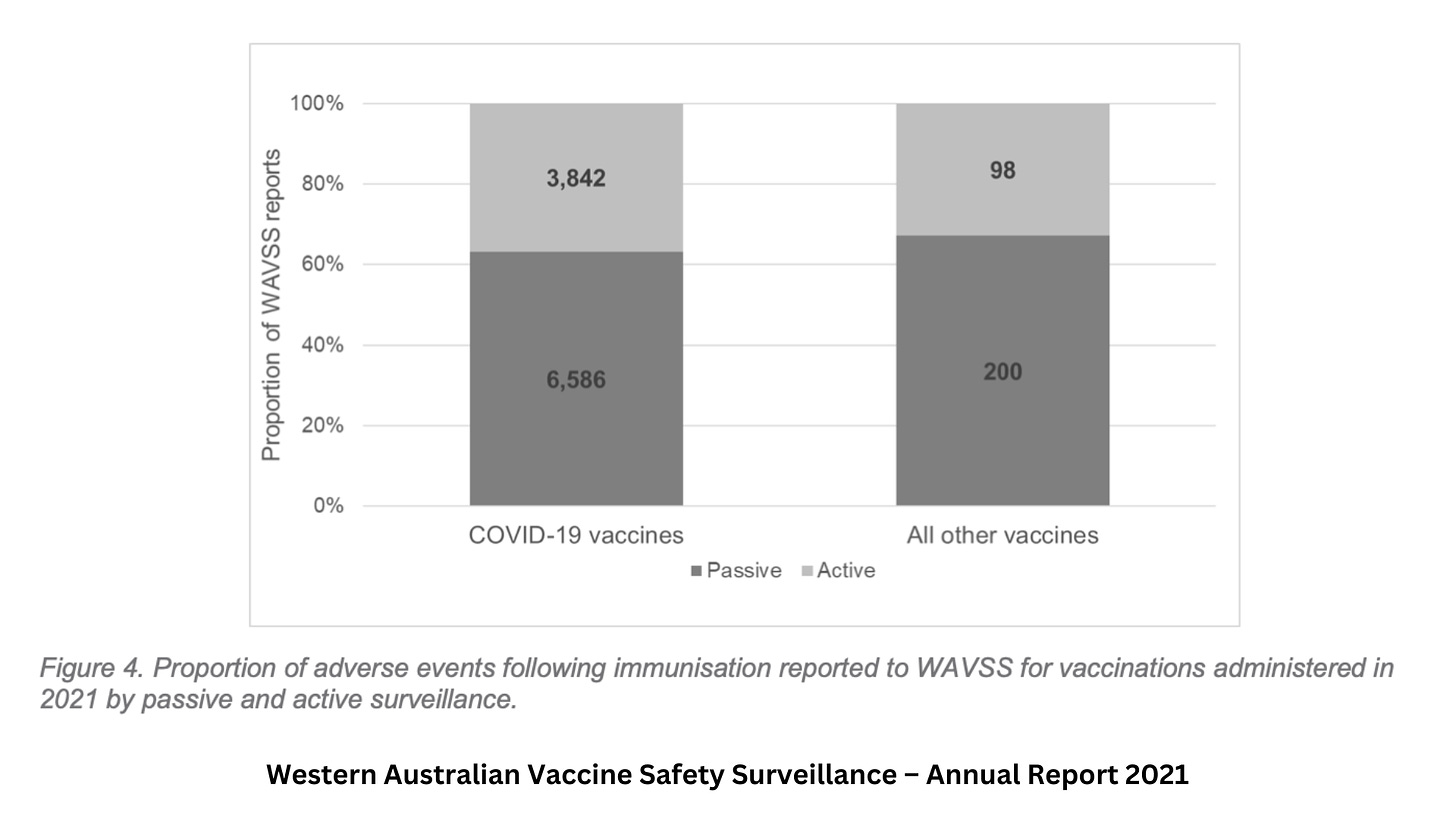

In 2021, WAVSS also began directly reporting AEFIs to the TGA. This is such baseline bureaucratic functioning, it probably should have been done years ago.
Finally, I acknowledge that the monitoring of serious AEFIs by WAVSS (e.g. TTS, myocarditis) in collaboration with the TGA did affect the recommendations by TGA and ATAGI, albeit nowhere near to the degree that it should have.
Final word from a friend of DDU
In the words of a Covid vaccine-injured West Australian who keeps a keen eye on the figures:
“The 2 sigma threshold is a warning signal that was clearly exceeded in 2021. This threshold was chosen by the WAVSS in their 2020 Annual Report, Fig. 2.8The chance of this happening randomly is less than 5% (and perhaps as low as 1.24%). Thus, the Covid Vaccines caused the high AEFI rate for 2021.”
”It’s astonishing that the AstraZeneca vaccine has not been withdrawn after causing 13 confirmed deaths in Australia. The Covid vaccines have verifiably caused death, as well as a range of other serious life-altering conditions to West Australians, including myself. They should have been withdrawn already.”
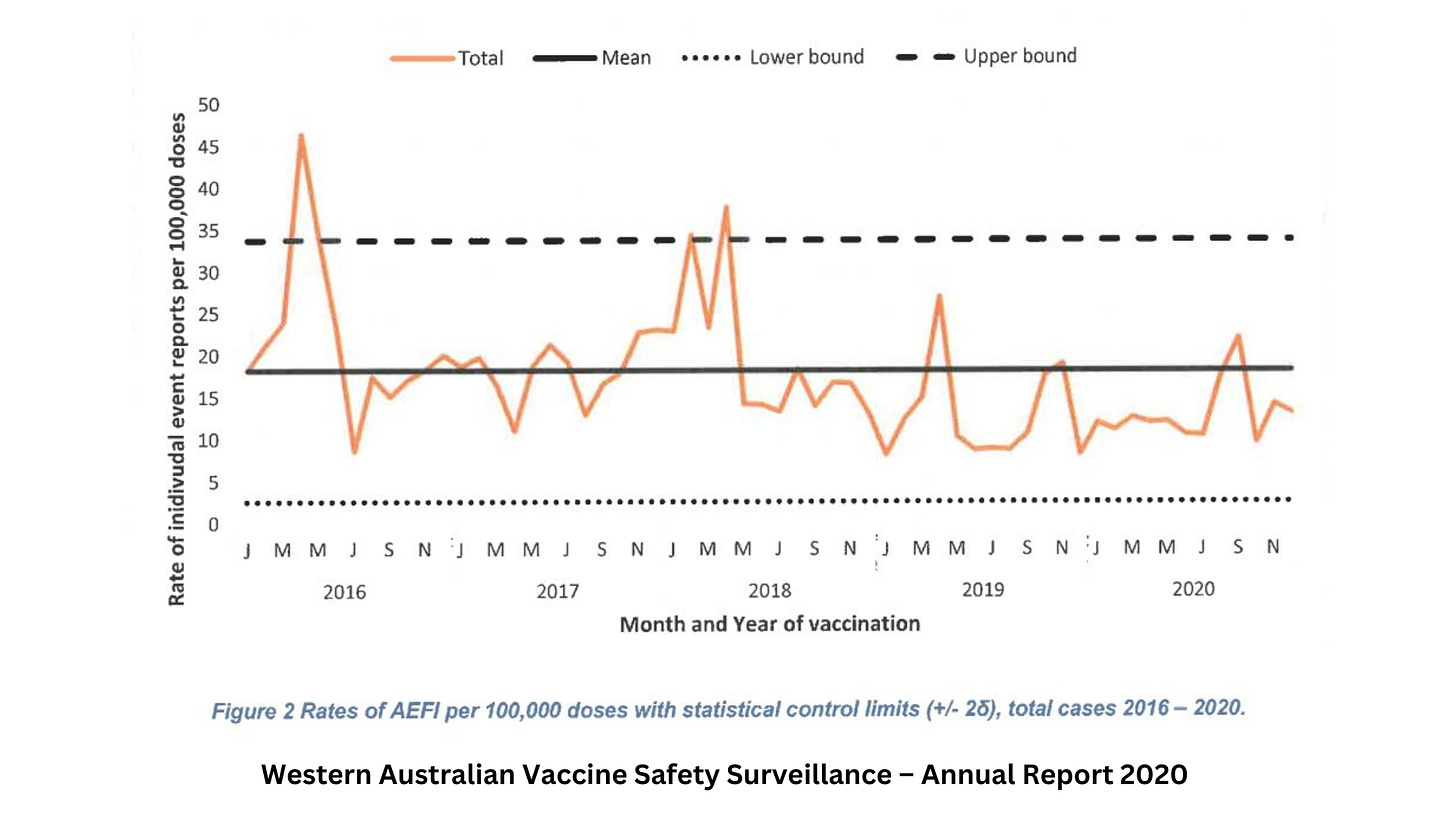
1. Western Australian Vaccine Safety Surveillance – Annual Report 2021
Archive link HERE
1.29MB ∙ PDF File – Download
2 By 31 December 2021, WA had seen just over 1, 500 Covid cases total, due to the state’s zero Covid policy during this time. That number includes international and interstate arrivals in quarantine. The number of cases in the community was far lower, ensured by snap lockdowns every time a community case was detected.
3. For the first time, in 2021, active surveillance data from SafeVax was included in the ED count. SafeVax cases account for 67% of reported AEFIs treated in ED for Covid vaccines in 2021. The significance of this detail is that the addition of active surveillance may partly explain the large jump from 20% AEFIs treated in ED in 2020, to 48% treated in ED for Covid vaccines in 2021. However, the percentage of AEFIs treated in ED for non-Covid vaccines in 2021 has not increased. I have contacted WA Health for clarity and will update accordingly.
4. President of the Australian Medical Professionals’ Society, Dr Chris Neil, offers further reasons why vaccine injuries are not reported by medical professionals in an opinion piece for Spectator, ‘Phelps breaks AHPRA’s culture of fear.’
5. Investigation Into Febrile Reactions in Young Children Following 2010 Seasonal Trivalent Influenza Vaccination
Alerts Medicine Seasonal Flu 100702
211KB ∙ PDF File – Download
6 From the report,
“In previous years, Western Australia’s Vaccine Safety Advisory Committee (WAVSAC) met twice a year to review state vaccine safety. In 2021, this Committee held additional meetings and then continued meeting weekly to review the vaccine safety from the WA COVID-19 vaccination program. The committee met 31 times in 2021. In May 2021, WAVSAC convened a specialist sub-group, the Expert Clinical Review Group (ECRG), to individually review WAVSS reports which required specialist assessment. The ECRG met 34 times in 2021 and reviewed 849 WAVSS reports.”
7. Varriccio, F et al (2004) Understanding vaccine safety information from the Vaccine Adverse Event Reporting System, The Pediatric Infectious Disease Journal, Volume 23 Issue 4, pp. 287-294
8. Western Australia Vaccine Safety Surveillance Annual Report, 2020
844KB ∙ PDF File – Download
Source – https://rebekahbarnett.substack.com/p/west-australian-government-finally
